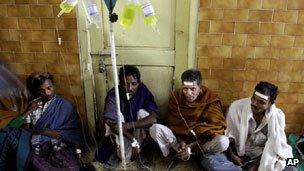Who, What, Why: Why are Indians dying from alcohol poisoning?
- Published

Hospitals in Calcutta are overflowing with patients suffering from alcohol-related ailments
More than 100 people have died after drinking toxic alcohol in the Indian state of West Bengal, in the latest example of fatal poisoning in the country. So why does it happen?
Stomach ache, vomiting, fits and even death.
The consequences of drinking illegal alcohol sold on India's streets could not be more serious. An estimated 126 people have died this week in West Bengal, but it's a problem that has blighted the country for years.
In 2008, at least 107 deaths were recorded in Karnataka, with another 41 in Tamil Nadu. The following year, more than 100 died in Gujarat, where alcohol is prohibited - the authorities last week introduced the death penalty for those supplying it.
One of the fatal ingredients is believed to be methyl alcohol, or methanol, a substance which sweetens it but which has industrial purposes as a solvent and antifreeze. Another is ammonium nitrate.
So why are such harmful substances being used to make alcoholic drinks?
One reason is the huge unfulfilled demand for booze which drives supply underground into an unregulated industry, says Aniruddha Mookherjee, who is writing a book about indigenous Indian alcohol.
"The state controls the alcohol business in India, almost completely. In many states, the alcohol is produced by state-appointed groups of people who are friends of the political parties that rule various states. West Bengal is one of the few states where this doesn't happen but in Delhi, for example, all alcohol is sold in government shops," he says.
Known as IMFL - Indian made foreign liquor - the legal supply is produced from molasses, a by-product of India's huge sugar industry. But a heavy duty means it's priced beyond the reach of about 80% of Indians, he says, so about 700ml of whisky or rum can cost as much as 400 rupees (£4.81).
In contrast, the illegal stuff, known as "hooch", derived from cane sugar, is sold for a fraction of the price, about 25 or 30 rupees for a plastic pouch or glass. It's sold discreetly by word of mouth. And without a culture of social drinking, says Mr Mookherjee, people are looking for something that can offer them a cheap kick.
But distilling it safely requires a precise control of the temperature, because if that rises above a certain level then methyl alcohol can form. Sometimes, certain herbs or chemicals might be added to increase the strength or improve the flavour, and these can react badly with other chemicals.
"It's usually a mistake because no-one who does this business wants people killed, because they end up with no business. There's sometimes an error of judgement or sometimes it's deliberately spiked by a rival. These are usually the two reasons why this happens."
So what do these kind of ingredients do to the body?
"When swallowed in high concentrations, ammonium nitrate may cause headache, dizziness, abdominal pain, vomiting, heart irregularities, convulsions, collapse, and death," says Dr Bob Patton of the Addictions Department at the Institute of Psychiatry at King's College, London.
"Methyl alcohol, or methanol, which is commonly used for antifreeze, can also be added to illicit liquor to increase its alcohol content. Methanol is highly toxic to humans, and ingestion of just 10ml can result in blindness, and 30ml or more is usually fatal."
There have also been cases in Europe of deaths resulting from illegal alcohol production. In Italy in 1986, 23 people died from drinking methanol-adulterated wine, and a year previously, diethylene glycol was found to have been added to Austrian white wine to make it sweeter, but fortunately no-one died.
Alcohol is a poison and in large doses it can kill, says Dr Patton, and the danger with alcohol produced illicitly is that the consumer does not know what substances have been used to produce the liquor, or indeed how much alcohol is present.
In the UK alone, about 500 people go to accident and emergency departments each week with alcohol poisoning, he adds.